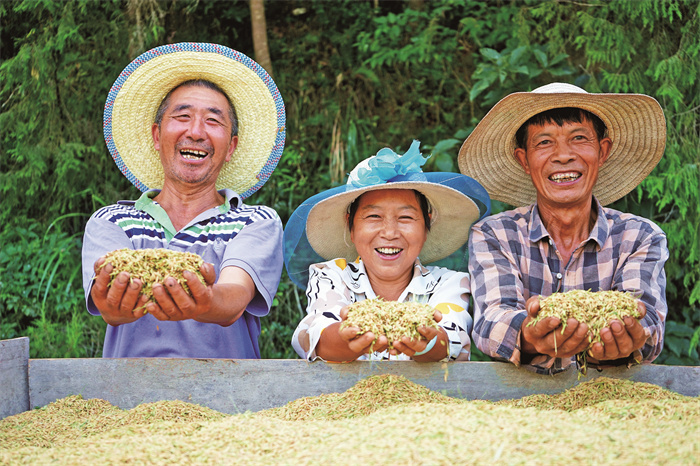Sichuan Bazhong strives to build higher-level granary I
Editor’s note : During the golden autumn season, the bustling scene of autumn harvest can be seen in the vast countryside of Bazhong, Sichuan province.
According to statistics, this year, Bazhong has cultivated 1.42 million mu (94,600 hectare) of small spring crops, an increase of 0.5% compared to last year, with a total output of 408,000 tons, an increase of 3.9% compared to last year.
According to industry dispatch, the city has cultivated 3.82 million mu of large spring crops, an increase of 0.6% compared to last year, with an expected output of 1.59 million tons, an increase of 4.1% compared to last year, presenting a promising harvest.
Growing various crops and producing good quality grains
"This year, Enyang district planted 256,000 mu of rice. Each town and village made early plans, prepared machinery for harvesting and drying, and launched a comprehensive battle to ensure that the grains are properly stored. A total of more than 1,860 large and small harvesters and over 20,000 people have been mobilized to work on the frontline of harvesting," said a representative of the Agriculture and Rural Affairs Bureau of Enyang District.
"In Tudian village, we have a long tradition of planting sorghums, and the villagers have a wealth of planting experience. However, in recent years, due to the migration of the young labor force, some land has been left fallow," said Xiong Jie, secretary of Party general branch in Tumen village, Shuning Temple town, Bazhou district.
In April last year, in order to solve the problem of fallow land, village cadres actively promoted the reclamation of fallow land and encouraged the participation of the masses.
Now, the whole village has planted more than 500 mu of sorghum and is expected to harvest about 350,000 catties of sorghum.
According to Li Zhiguo, deputy director of the Agriculture and Rural Affairs Bureau of Pingchang County, in order to ensure food security, county-level agricultural technicians are stationed in villages to provide technical guidance on spring planting, summer management, autumn harvest, and pest control. At the same time, improved varieties have been introduced for promotion. This year, the rice yield in Pingchang County has increased to varying degrees compared to last year.

A bumper harvest for villagers in Jinbei village, Sanxi town, Tongjiang county [Photo provided to spotlightbazhong.com]
In Jinbei village, Sanxi town, Tongjiang county, rice has also ripened. "I planted 60 mu of rice this year, and the yield is quite good," said Qu Yangwu, a major rice grower in Jinbei village.
In recent years, Tongjiang county has made great efforts to improve rice varieties, seedling cultivation, and planting techniques, not only ensuring the "rice bags" of the masses, but also improving their incomes.

A beautiful picture painted with colorful rice in Changchi town, Nanjiang county [Photo provided to spotlightbazhong.com]
Currently, rice in Nanjiang county has also entered its golden harvest period, and the local people are working hard to ensure that every grain of rice is properly stored.
According to the introduction, this year, the total rice planting area in Bazhong city has reached 1.46 million mu, and the average yield per mu is expected to increase by more than 15 kilograms compared to last year. The harvest is expected to be completed by the end of September, with a total of 1.36 million mu of corn, 1.455 million mu of rice, 480,000 mu of sweet potatoes, 355,000 mu of soybeans, and 170,000 mu of other grains such as sorghum having been planted.
As of now, the corn harvest has almost ended, the rice harvest progress has exceeded 80%, and the sweet potatoes are growing well and are expected to have a good harvest.
At the same time, Bazhong is also focusing on autumn corn, potatoes, sweet potatoes, and expanding the cultivation of soybeans. It has planned and implemented the production of 300,000 mu of late autumn grains as early as possible.

